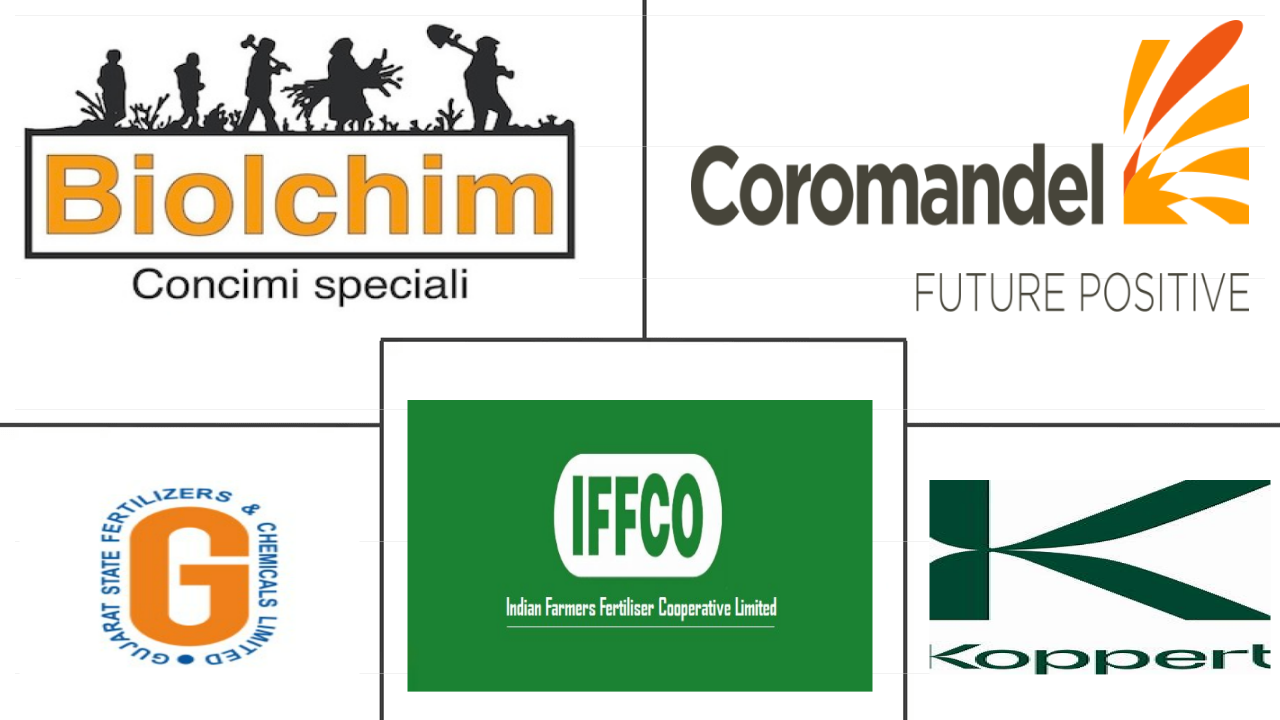Market Size of asia-pacific agricultural biologicals Industry
|
|
Study Period | 2017 - 2029 |
|
|
Market Size (2024) | USD 8.94 Billion |
|
|
Market Size (2029) | USD 13.67 Billion |
|
|
Largest Share by Function | Crop Nutrition |
|
|
CAGR (2024 - 2029) | 8.87 % |
|
|
Largest Share by Country | China |
Major Players |
||

|
||
|
*Disclaimer: Major Players sorted in no particular order |
Asia-Pacific Agricultural Biologicals Market Analysis
The Asia-Pacific Agricultural Biologicals Market size is estimated at 8.94 billion USD in 2024, and is expected to reach 13.67 billion USD by 2029, growing at a CAGR of 8.87% during the forecast period (2024-2029).
8.94 Billion
Market Size in 2024 (USD)
13.67 Billion
Market Size in 2029 (USD)
3.00 %
CAGR (2017-2023)
8.87 %
CAGR (2024-2029)
Largest Segment by Form
28.70 %
value share, Macrobials, 2023
Predators dominated the macrobials segment with a market share of 87.1% in 2022. The dominance of the predators' segment is mainly due to their ability to attack pests.
Largest Segment by Type
45.35 %
value share, Organic Fertilizer, 2023
Organic fertilizers are the most consumed fertilizers in Asia pacific region under agricultural biologicals. Manure as organic fertilizer is dominant in the region.
Largest Segment by Crop Type
80.74 %
value share, Row Crops, 2023
The dominance of row crops is mostly attributable to their extensive organic cultivation area, which in 2022 accounted for 67.5% of all organic crop land in the region.
Largest Segment by Country
50.65 %
value share, China, 2023
China is the major market for agricultural biologicals market in the region, and crop nutrition products are holding major market share in the country with 86.4% in 2022.
Leading Market Player
2.70 %
market share, Gujarat State Fertilizers & Chemicals Ltd, 2022

Gujarat State Fertilizers & Chemicals Limited is involved in the manufacture of biofertilizers, biopesticides and biostimulants, and marketed with the Sardar brand name.
- In the Asia-Pacific region, agricultural biologicals play a key role in sustainable agriculture. These products reduce the use of chemical fertilizers and pesticides by providing required nutrients and controlling pests and insects in crops. The agricultural biologicals market in the region is growing Y-o-Y. From 2017 to 2022, the market value increased by 9.4%.
- The demand for biological solutions in Asia-Pacific is being driven primarily by export markets such as the European Union, which is tightening regulations on the use of some conventional pesticides and local consumer and customer demand for more sustainably grown food. Thus, more growers are showing a growing interest in alternative solutions. The most promising segments are high-value fruits and vegetables (e.g., berries and grapes) eaten fresh and crops grown in greenhouses.
- PAN Asia Pacific (PANAP), one of five regional centers of the Pesticide Action Network, is creating an awareness campaign regarding the harmful effects of pesticides on humans and the environment and promoting biodiversity-based ecological agriculture.
- Countries such as China, India, Australia, and Indonesia are adopting organic farming strategies. China and India are the major countries holding shares of 51.3% and 31.6%, respectively, of the agricultural biologicals market in the region. These countries are implementing different initiatives to encourage organic farming and agricultural biologicals usage widely. For instance, China is planning to reduce 10% and 5% pesticide usage in horticultural crops and row crops, respectively. India, through many initiatives like PKVY and MOVCDNER, provides financial support to farmers to buy agricultural biologicals for organic farming.
- The Asia-Pacific region is one of the world's major organic producers. Rice, sugarcane, and fresh fruits and vegetables are among the major organic crops cultivated in the region. China and India are the region's main organic crop producers and have the highest organic product consumption markets.
- The area of the region that was organically farmed increased significantly over the historical period (2017–2022), rising from 3.1 million hectares in 2017 to 3.8 million hectares in 2022. The region's biologicals market increased by 10.1% during the historical period and is expected to increase by about 65.1% over the forecast period, reaching USD 13.6 billion by the end of the forecast period.
- As an individual country, China dominated the Asia-Pacific agricultural biologicals market in 2022 by 75.6% of the market value and 80.7% of the market volume. India occupied second place with 16.9%, the Rest of Asia-Pacific held 3.3%, and Indonesia held 1.5% of the total Asia-Pacific biologicals market values the same year.
- In 2022, row crops in the Asia-Pacific region consumed more biological fertilizers, accounting for 80.3% of the total market value. This is due to the region's huge area under cultivation of field crops, as they are the stable food in many countries in the region. This is followed by cash crops and horticultural crops, which had 11.0% and 8.6% shares, respectively, in the same year.
- The rising trend in organic crop areas and the rising demand for organic products and organic fertilizers reduce overall chemical fertilizer use. The overall cost of crop production and government attempts to encourage organic farming are expected to drive the Asia-Pacific biologicals market during the forecast period.
Asia-Pacific Agricultural Biologicals Industry Segmentation
Crop Nutrition, Crop Protection are covered as segments by Function. Cash Crops, Horticultural Crops, Row Crops are covered as segments by Crop Type. Australia, China, India, Indonesia, Japan, Philippines, Thailand, Vietnam are covered as segments by Country.
- In the Asia-Pacific region, agricultural biologicals play a key role in sustainable agriculture. These products reduce the use of chemical fertilizers and pesticides by providing required nutrients and controlling pests and insects in crops. The agricultural biologicals market in the region is growing Y-o-Y. From 2017 to 2022, the market value increased by 9.4%.
- The demand for biological solutions in Asia-Pacific is being driven primarily by export markets such as the European Union, which is tightening regulations on the use of some conventional pesticides and local consumer and customer demand for more sustainably grown food. Thus, more growers are showing a growing interest in alternative solutions. The most promising segments are high-value fruits and vegetables (e.g., berries and grapes) eaten fresh and crops grown in greenhouses.
- PAN Asia Pacific (PANAP), one of five regional centers of the Pesticide Action Network, is creating an awareness campaign regarding the harmful effects of pesticides on humans and the environment and promoting biodiversity-based ecological agriculture.
- Countries such as China, India, Australia, and Indonesia are adopting organic farming strategies. China and India are the major countries holding shares of 51.3% and 31.6%, respectively, of the agricultural biologicals market in the region. These countries are implementing different initiatives to encourage organic farming and agricultural biologicals usage widely. For instance, China is planning to reduce 10% and 5% pesticide usage in horticultural crops and row crops, respectively. India, through many initiatives like PKVY and MOVCDNER, provides financial support to farmers to buy agricultural biologicals for organic farming.
| Function | ||||||||||||||||||||||||
| ||||||||||||||||||||||||
|
| Crop Type | |
| Cash Crops | |
| Horticultural Crops | |
| Row Crops |
| Country | |
| Australia | |
| China | |
| India | |
| Indonesia | |
| Japan | |
| Philippines | |
| Thailand | |
| Vietnam | |
| Rest of Asia-Pacific |
Asia-Pacific Agricultural Biologicals Market Size Summary
The Asia-Pacific Agricultural Biologicals Market is experiencing significant growth, driven by the increasing demand for sustainable agricultural practices. This market is pivotal in reducing reliance on chemical fertilizers and pesticides by offering natural alternatives that provide essential nutrients and pest control. The region's market is expanding year-on-year, with a notable increase in value over recent years. The push towards biological solutions is largely influenced by export markets like the European Union, which are imposing stricter regulations on conventional pesticides, and by local consumer preferences for sustainably produced food. High-value crops, particularly fresh fruits and vegetables, are emerging as key segments within this market. Countries such as China, India, Australia, and Indonesia are at the forefront of adopting organic farming strategies, supported by government initiatives that encourage the use of agricultural biologicals.
China and India dominate the market share in the region, with substantial efforts to promote organic farming and reduce chemical inputs. The area under organic cultivation has seen significant growth, with row crops, horticultural crops, and cash crops being the primary categories. The demand for organic products is on the rise, driven by increasing consumer awareness and the health and wellness trend. The market for organic goods remains fragmented, with limited availability in supermarkets and specialty stores, but is expected to grow as consumer knowledge and income levels rise. Major players in the agricultural biologicals market include Biolchim SpA, Coromandel International Ltd, Gujarat State Fertilizers & Chemicals Ltd, Indian Farmers Fertiliser Cooperative Limited, and Koppert Biological Systems Inc. These companies are actively expanding their portfolios to include organic fertilizers and other sustainable products, reflecting the broader industry trend towards ecological and sustainable agricultural practices.
Asia-Pacific Agricultural Biologicals Market Size - Table of Contents
-
1. MARKET SEGMENTATION (includes market size in Value in USD and Volume, Forecasts up to 2029 and analysis of growth prospects)
-
1.1 Function
-
1.1.1 Crop Nutrition
-
1.1.1.1 Biofertilizer
-
1.1.1.1.1 Azospirillum
-
1.1.1.1.2 Azotobacter
-
1.1.1.1.3 Mycorrhiza
-
1.1.1.1.4 Phosphate Solubilizing Bacteria
-
1.1.1.1.5 Rhizobium
-
1.1.1.1.6 Other Biofertilizers
-
-
1.1.1.2 Biostimulants
-
1.1.1.2.1 Amino Acids
-
1.1.1.2.2 Fulvic Acid
-
1.1.1.2.3 Humic Acid
-
1.1.1.2.4 Protein Hydrolysates
-
1.1.1.2.5 Seaweed Extracts
-
1.1.1.2.6 Other Biostimulants
-
-
1.1.1.3 Organic Fertilizer
-
1.1.1.3.1 Manure
-
1.1.1.3.2 Meal Based Fertilizers
-
1.1.1.3.3 Oilcakes
-
1.1.1.3.4 Other Organic Fertilizers
-
-
-
1.1.2 Crop Protection
-
1.1.2.1 Biocontrol Agents
-
1.1.2.1.1 Macrobials
-
1.1.2.1.2 Microbials
-
-
1.1.2.2 Biopesticides
-
1.1.2.2.1 Biofungicides
-
1.1.2.2.2 Bioherbicides
-
1.1.2.2.3 Bioinsecticides
-
1.1.2.2.4 Other Biopesticides
-
-
-
-
1.2 Crop Type
-
1.2.1 Cash Crops
-
1.2.2 Horticultural Crops
-
1.2.3 Row Crops
-
-
1.3 Country
-
1.3.1 Australia
-
1.3.2 China
-
1.3.3 India
-
1.3.4 Indonesia
-
1.3.5 Japan
-
1.3.6 Philippines
-
1.3.7 Thailand
-
1.3.8 Vietnam
-
1.3.9 Rest of Asia-Pacific
-
-
Asia-Pacific Agricultural Biologicals Market Size FAQs
How big is the Asia-Pacific Agricultural Biologicals Market?
The Asia-Pacific Agricultural Biologicals Market size is expected to reach USD 8.94 billion in 2024 and grow at a CAGR of 8.87% to reach USD 13.67 billion by 2029.
What is the current Asia-Pacific Agricultural Biologicals Market size?
In 2024, the Asia-Pacific Agricultural Biologicals Market size is expected to reach USD 8.94 billion.

